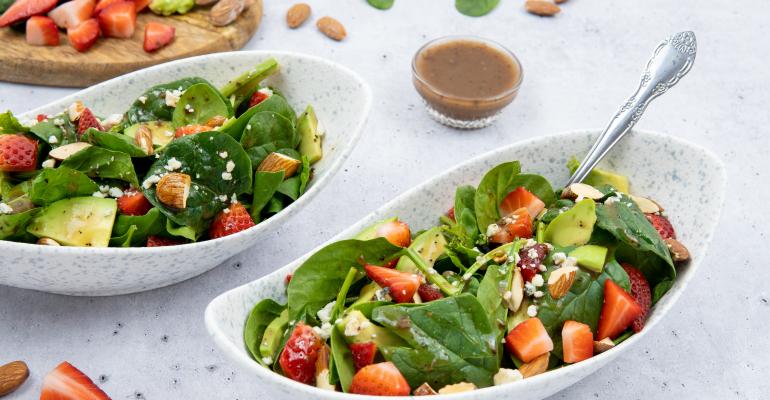Sponsored by Litehouse
Even before the pandemic, functional foods—those with benefits that extend beyond basic nutrition—were making their way out of holistic hiding and onto mainstream consumers’ plates. Now, 29% of consumers say they’re using more functional foods and supplements, according to The Hartman Group’s Functional Food and Beverage Report 2020.
But when it comes to defining whether or not consumers have eaten well, their desire for nutritious food is second only to eating good-tasting food, according to the latest research from the Food Marketing Institute. One way to meet demand for both function and flavor is by including entrée salads on the menu.
Foods with purpose
Before developing new entrée salads with health benefits, operators will want to better understand what foods are included in the functional category and their associated health benefits.
Many nutrient-rich ingredients like fruits, vegetables, nuts, seeds and grains are considered functional foods. Spinach, red bell pepper and citrus fruits, for example, all contain vitamins and minerals that may increase the infection-fighting ability of our immune systems. Berries are bursting with disease-fighting antioxidants. Tofu is made from soybeans, which contain all nine essential amino acids needed for healthy muscles and bone, plus omega-6 and omega-3 fats that are good for heart health and warding off certain diseases. Cold-water fatty fish, such as salmon, mackerel, tuna, herring and sardines, all contain high amounts of LC omega-3s, which have a wide range of benefits that range from providing energy for the body to reducing risk factors for heart disease to fighting inflammation.
While many foods contain these and other health benefits, The Hartman Group found that the functions today’s consumers seek most are those that deliver a boost to the immune system or support digestion.
Those individuals most likely to purchase functional foods tend to be women and adults in mid-life, however, a recent study conducted by the National Institutes of Health reveals the appeal of these ingredients is broadening. For example, emerging adults (ages 18 to 29) are paying more attention to what they eat than previous generations, and they are more willing to pay a premium for foods that prevent diseases or reduce health risks. Also more likely to purchase functional foods are households with young children and those in a higher socio-economic status.
Simple but flavorful
Incorporating functional ingredients into entrée salads is easy. In fact, many of these ingredients are already on menus. Try incorporating the functional foods with on-trend flavors consumers prefer most, for example:
- Salads with more protein Fresh mixed greens with chicken, avocado and hard-boiled eggs tossed in avocado cilantro ranch and topped with cheese crunchy pecans.
Fast Fact: U.S. consumers have a high preference for chicken, avocado and hard-boiled eggs on entrée salads.
- Simple Salad with Omega-3s. Spring Mix topped with shrimp, diced avocado, roma tomato, cucumber, and red onion tossed in a jalapeno ranch dressing.
Fast Fact: U.S. Total Female consumers strongly preferred 'Avocado' on their entree salads.
- It’s Soy Good Salad: Crispy Thai marinated chicken served over cole slaw blend mixed with greens topped with broccoli, cucumber, red pepper, whole cashews and green onion tossed in sesame ginger dressing.
Fast Fact: While many young consumers haven’t yet tried plant-based proteins in a salad, approximately one quarter of U.S. consumers express interest in giving them a chance.
- Nutrient Rich Spinach Salad: Spinach layered with apple and pear and blood orange slices, topped with almonds, shallots and drizzled with blue cheese dressing.
Fast Fact: Apples ranked in the top three fruits for western respondents.
Ongoing impact
Restaurant operators interested in adding functional foods may be wondering how to call out or explain that certain ingredients are good for, say, gut health or warding off deadly diseases. For most restaurants, experts observe, it’s not necessary to spell out the details. It’s enough to merely have these ingredients on the menu. Additionally, operators can employ icons to call out functional ingredients on the menu but should avoid making any specific health claims.
Whether reimagining existing salads or creating them from scratch, operators don’t have to be R+D experts. Instead, many operators look to foodservice manufacturers to provide insights into consumer preferences when developing their next entrée salad to go.
With U.S. consumers' current health preferences forecasted to continue, entrée salads that feature functional foods and exciting flavors will be attractive menu items for the foreseeable future.




